Ionization, Oxygenation and Improved Filtration
Links to grower technology articles on copper ionization.
- Sensitivity to copper and phosphite of Phytophtora species associated with ink diseases of chestnut
- Reports an experiment to determine the toxicity of copper ions to Phytopthora in chestnut. Inhibition of Phytophthora growth increased with increasing copper concentrations.
Chelho, V., S. Coutinho, and M.E. Gouveia (Instituto Politecnico de Braganca, Portugal)
Acta Horticulturae Volume 693: 641-643
2005
- Greenhouse pepper growth and yield response to copper application
- Tests for phytotoxic responses to copper in young and old hydroponically grown pepper plants.
Zheng, Y., L. Wang, and M. Dixon (University of Guelph, Canada)
HortScience Volume 40 Issue 7: 2132-2134
2005
- Response to copper toxicity for three ornamental crops in solution culture
- Tests to determine level where phytotoxic responses to copper become apparent in three ornamental crops.
Zheng, Y., L. Wang, and M. Dixon (University of Guelph, Canada)
HortScience Volume 39 Issue 5: 1116-1120
2004
- Back to the basics, Part 3
- In this last section of a three-part series, the use of ozone, copper and silver ionization, distillation and aeration is discussed.
Roseman, J. (Aqua Ion Plus+ Technologies)
Water Quality Products Volume 7 Issue 7: 16-19
2002
- Reclaim greenhouse water
- The need for reclaiming water, and the need for treating reclaimed water, are discussed. The article then describes a study of the use of copper ionization and ozone to control Pythium.
Roseman, J. (Aqua Ion Plus+ Technologies)
Water Quality Products Volume 6 Issue 10
2001
- Hygiene in the nursery: Disinfecting production surfaces; cement, gravel, capillary mats and sand beds
- Advice and guidelines for sanitizing porous surfaces in the greenhouse. Tested efficacy of copper ionization, chlorination, and quaternary ammonium compounds against fungi, bacteria, and nematodes on several different surfaces.
Stovold, G. (Tropical Fruit Research Station, Alstonville, AU)
The Nursery Papers Volume 2000 Issue 5: 1-4
2000
- The effect of silver and other metal ions on the in vitro growth of root-rotting Phytophthora and other fungal species
- Tests the toxicity of a range of ions to Phytophthora, and finds that copper to be of relative high toxicity, second only to silver. Note that this article focuses primarily on silver.
Slade, S.J. and G.F. Pegg (University of Reading, UK)
Annals of Applied Biology Volume 122: 233-251
1993
- Copper ionization
- Copper ionization discussion from our series on water treatment for pathogens and algae.
Fischer, R., P. Fisher, and A. Frances (Water Education Alliance for Horticulture)
GMPro, Dec. 2008:18-21
Water treatment with copper ionization
Modern copper ionization treatments are more effective, precise and environmentally responsible than their older counterparts. Copper has been used for centuries as a fungicide, mostly in the form of copper sulfate or mixed with lime as Bordeaux mixture. You may be familiar with traditional copper sulfate fungicides that were applied to grape plants and left blue stains on the leaves.
The modern process of copper ionization uses electricity to harness the natural molecular properties of copper. Because soluble copper ions lack two electrons, they are "eager" to bond with other suitable atoms that can supply the missing electrons. When copper ions encounter organic matter, including plant pathogens, they firmly attach themselves and disrupt the pathogensí cell walls, killing the organisms.
Studies by professor Walter Wohanka at Geisenheim Research Center in Germany and in the United States demonstrated that 0.5 to 1 parts per million (ppm) of free copper significantly reduced Pythium, Phytophthora, Xanthomonas and other waterborne pathogens, while 1 to 2 ppm effectively reduced algae.
Improved effectiveness
One reason copper ionization was effective for only some growers in the past is that copper atom output changes depending on the water flow and electrical conductivity. As the electrical conductivity fluctuates with the quality of the water, especially in pond and recirculation systems, the electric current between the electrodes also changes
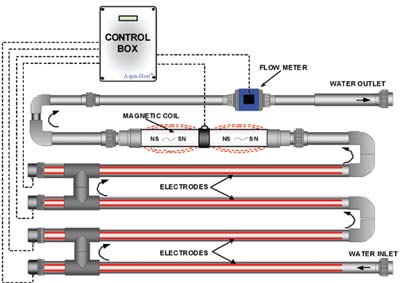
This Aqua-Hort copper system is equipped with copper electrodes inside pipes. An electric current passes through he system to turn solid copper metal electrodes into soluble copper ions. A magnetic coil increases activity of the copper ions. The control box corrects ionization rate based on water flow and water electrical conductivity to maintain a constant copper concentration.
Evaluation of Electrolysis Produced Super-Oxygenated Water on Plant Growth (2006)
Albert H. Markhart III
Department of Horticultural Science
University of Minnesota
St. Paul, MN 55110
Introduction: Flooding, soil compaction, pot bound roots all reduce the availability of oxygen to plant root systems causing reduced growth, poor quality, and decreased yield. The green industry invests considerable time and money to develop potting mixes with optimal air space and water holding capacity. Plant hobbiests as well as plant professionals are cautioned to not over-water or flood plants because of the rapid loss of oxygen in the rhizosphereresulting in reduced root growth, function, and disease susceptibility.
Techniques to supplement irrigation water with oxygen improve plant growth. Air injection (Bhattaria et al. 2004) and hydrogen peroxide additions to the irrigation water (Walter et al. 2004) increased oxygen to plant root systems and improved plant performance. Both of these techniques, however, have limitations. The experiments presented in this paper use a novel electrolysis technology to produce micro-bubbles of oxygen that are forced into solution producing super-saturated oxygenated water. Regular watering with the super-oxygenated water compared to regular watering with typical well water significantly increased flower production in petunia and geranium, but had no effect on cyclamen. The super-oxygenated water also increased the foliage color intensity and over-all plant quality in coleus.
Methods: One gallon watering containers fitted with the oxygenating units (supplied by Ovation Sciences) were capable of increasing the oxygen level in the water to at least 180% in 20 minutes (Fig 1). Petunia, coleus, and geranium plugs were grown in 4 inch pots containing a standard soil mix in the University of Minnesota greenhouse during February and March of 2006. Greenhouses were set at 75 F during the day and 65 F the night. Plants were supplied with supplemental light set on an 18 hour photoperiod from HID lights. We conducted two separate experiments. Experiment 1 compared water saturated at 100% (typical of well aerated surface water), with 180% super-oxygenated water. Experiment 2 compared water containing 30% oxygen (typical of ground water obtained from wells), with 180% oxygenated water. Plants were watered daily under flooded or non-flooded conditions for about 6 weeks. Flooded conditions were produced by placing a 1 inch high saucer under the pots. Plants were arranged in a completely randomized block design with eight replications. Plant size, dry weights, flower number, and quality ranking on a 1 to 7 scale were made at the end of the experiment.
Results: In experiment 1, flooded plants were smaller and produced fewer flowers than the non-flooded plants, however, there was no effect of the super-oxygenated water in plant size of flowering. In experiment 2 plants were again significantly affected by the flooding treatment, however, the super-oxygenated water significantly increased flowering and plant quality compared to the control plants. Petunia plants had on average 28% more flowers when watered with super-oxygenated water compared to controls (Figure 2). Geranium plants had 75% more total flower weight compared to plants watered with control water (Figure 3). This was in part due to the more rapid flowering in the super-oxygenated treated plants. Coleus plants watered with 180% oxygen had more vibrant foliage and were consistently ranked higher than the control plants (Figure 4).
Discussion: Plant root systems must be able to respire to grow and absorb water and nutrients. Without adequate oxygen the root can not perform these necessary functions and plant growth and quality suffer. Optimal production conditions or the knowledgeable homeowner using proper watering and maintenance for their house plants adequate oxygen is provided to the rhizosphere. There are, however, times of over-watering, pot-binding, flooding, where adequate oxygen is not provided from the atmosphere to the root system. Even though oxygen is not readily soluble in water it appears that the boost oxygen supplied from the super-oxygenated water can improve plant performance. The simplicity and low power requirements of the electrolysis oxygenation system coupled with the potential for significant increase in plant performance suggests that under oxygen deficient conditions electrolysis produced supra-oxygenated water is a viable production alternative for the commercial grower and a benefit for the homeowner.
Figure 2: Effect of super-oxygenated water on the average number of flowers on petunia plants. Non-flooded (NF) plants had more flowers than flooded (F) plants. Within each group, plants watered with super-oxygenated (O) water had more flowers than the controls (C).
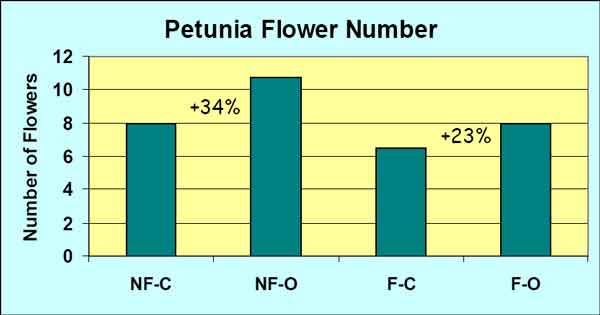
Figure 3: Effect of super-oxygenated water on the average total flower weight per geranium plant. Non-flooded (NF) plants did not have more flower weight than the flooded (F) plants. However, within each group, plants watered with super-oxygenated (O) water had more total flower weight per plant than the control plants (C).
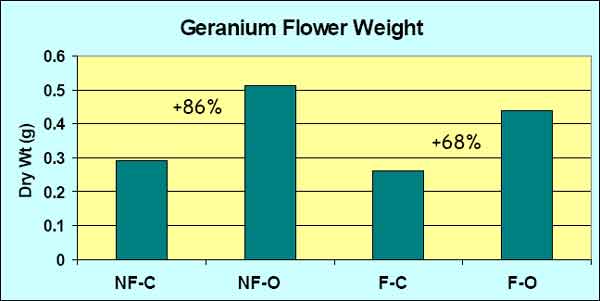
Figure 4: Effect of super-oxygenated water on coleus plant quality. Coleus plants watered with super-oxygenated water had greater depth of color especially in the red and purple parts of the leaves. The plants watered with super-oxygenated water had higher quality rankings than the plants watered with control water.
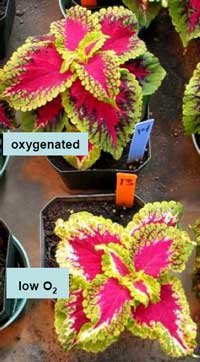
Figure 1: Time course of oxygenation of tap water with standard aquarium bubbler placed in a one gallon watering can and an identical watering can fitted with an electrolysis unit supplied by Ovation Science. Power was applied to the electrolysis unit at time 0 and turned off after thirty minutes. Power was supplied to the aquarium bubbler for three hundred minutes. Oxygen concentration was monitored in both watering cans with a Hack oxygen meter model HQ40d.
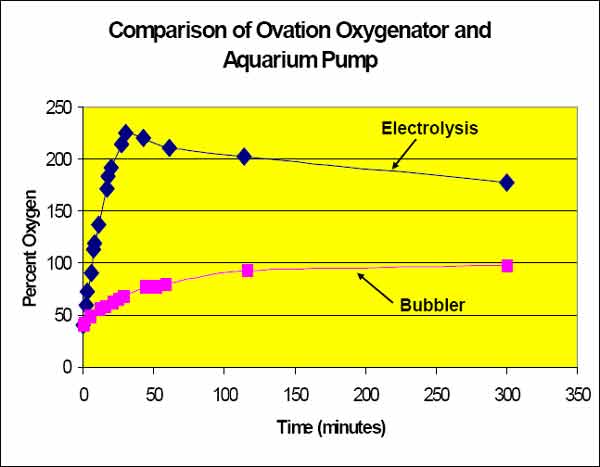
Footnotes:
References: Increased Oxygenation Benefits on Growth and Yield
Bhattaria, SP, S Huber and DJ Midmore 2004 Aerated subsurface irrigation water gives growth and yield benefits to zucchini, vegetable soybean and cotton in heavy clay soils Annals of Applied Biology144 (3) :285-300
Walter S, H Heuberger and WH Schnitzler 2004 Sensibility of Different Vegetables to Oxygen Deficiency and Aeration with H2O2 in the Rhizosphere. Proc. VII IS on Prot. Acta Hort. 659, ISHS 2004
Water Treatment for Pathogens and Algae Series
|
|